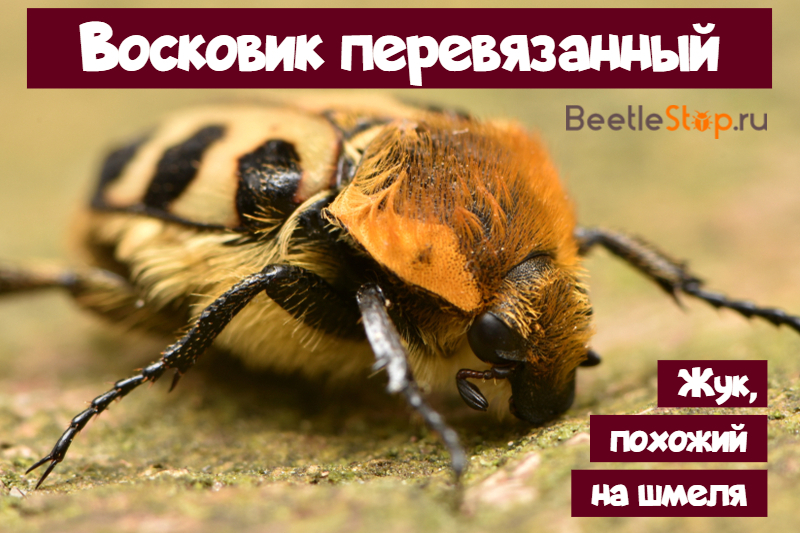Waxed up bandaged - a summer motley on a dogrose
Waxes belong to the lamellar family. Small beetles are distinguished by a large number of hairs on the body and variegated elytra. A common color scheme is yellow with black bandages. In summer, on the flowers of a wild rose you can see a beetle similar to a bumblebee. This is a wax stub, his chest and abdomen are abundantly covered with thick reddish hairs. Beetles fly all summer. They are found in deciduous forests, in the south - in the mountains. The larvae are completely unlike their parents. Worm-like offspring secretly lives in rotten stumps.

View description
Bandaged waxwort (Trichiusfasciatus) or striped waxwax (ordinary) is a representative of the lamellar family, the genus of waxwax. The body length of the beetle is 9-15 mm, the shape is wide. The main color is black. The head is small, directed forward. Antennae 10-segmented with a characteristic 3-segmented lamellar club, opening in the form of a fan. Eyes of facet type, large and convex. The head is covered with dots and long yellow hairs.
Pronotum already elytra, its widest part located in the middle. The front edge is greatly narrowed. The lateral parts are rounded, the front and rear corners are obtuse. Pronotum fully pubescent. Insect hairs are colored reddish yellow or gray. The elytra are opaque, slightly convex, there are several shiny tubercles and longitudinal grooves. The main background is light yellow, the pattern is in the form of black stripes along the side edge and seam. Elytra shorter than abdomen in length; part of it remains uncovered. On the surface of the elytra, there are three transverse bands, successively extending from the base to the posterior edge. Medium discontinuous.
Light transparent wings are well developed. Beetles fly in search of food, escape from danger. Abdomen is black, segmented. The posterior end, looking out from under the elytra, is covered with long red hairs. Legs are long, slender, covered with dense rough punctures. On the anterior tibia there are two teeth outside, on the hind limbs - a spike outgrowth. The paws end with sharp claws.
Interesting fact. The English name for the species Beebeetle means "beetle-like bug." The reason for the nickname was a thick pubescence of yellow-black insects.
Color variability
The elytra pattern changes significantly in insects living in different areas. The ratio of yellow and black changes in different variations. This variability is called aberration. It occurs accidentally under the influence of temperature and other factors acting on the larval stage. There are individuals with a short front and middle band, beetles with a predominance of black or yellow. In dubius aberration, the bandages are reduced to dark spots on the shoulders. The obliquus insect group is characterized by an oblique middle band extending from the shoulder to the seam at the apex of the elytra.
Distribution area
Striped waxwort is common throughout the Palearctic. The northern border of the habitat passes through the Arctic, in the south - through the mountains of the Caucasus and the Tien Shan. Beetles are found throughout Europe: Norway, the UK, Portugal, Spain, Bulgaria, the Baltic countries. In the east, lives in Mongolia, northern China, Japan.In Russia, the common waxwort lives on the shores of the Sea of Okhotsk and the White Sea, in the central regions. There is an isolated insect population in the Kuril Islands, Kamchatka, and Sakhalin. In the mountains of the Caucasus, beetles live at an altitude of 2000 m, and in the Tien Shan rise to 1600 m.
Information. Kind of a waxed tied up is listed in the Red Book of Moscow. Beetles are common in the region, but in the capital their population is declining. Negative factors: mowing forbs to create lawns, hunting for beetles because of their decorativeness. The reduction in the number of insects is facilitated by the destruction of dead wood in the parks, which is the site of development of larvae.
Lifestyle
Common waxwort refers to summer species. Beetles appear in May-June, fly all summer until September. In the subtropical zone (Transcaucasia), adults come to the surface in April. Habitats - warmed edges of broad-leaved and mixed forests, clearings and meadows, overgrown with tall grass and shrubs. Insects are often found in gardens and vegetable gardens. They feed on carrots, parsley, dill. Beetles are not pests, but beneficial insects. Many pollen clings to the numerous hairs of a striped waxwort, flying between flowers, they contribute to cross-pollination.
Insects are active in the daytime, during the rain they hide under the trees. Most of the time, adults sit on flowering herbaceous plants, burying their heads in the inflorescence. They feed on pollen and nectar, prefer umbellate (hemlock, hogweed, angelica), wild rose, elderberry.
Reproduction and development of offspring
The breeding season is in early June. Fertilized females lay 20-40 oval eggs under the bark, in hollows and cracks of deciduous trees. Larvae live in rotten wood, stumps and large deadwood. Most often found in the outer part of dry rotted trunks and branches lying on the ground. Favorite species of larvae are aspen, birch, alder, oak. At birth, they are not more than 5 mm; by the end of development they reach 40 mm.
The body structure is characteristic of the lamellar family - C-shaped, cylindrical, not very thick. The color is off-white. The head is small, matte, brownish-yellow. The upper jaws are wide and well developed. There are simple eyes. Antennae 4-segmented. Moves with the help of three pairs of short legs. The larva passes 3 ages. In a temperate and warm climate, one generation develops per year. Larvae hibernate in wood, and pupate in the cradle in spring. Pupa, soft, loose. In the far north, offspring do not have time to form in a short warm season, development is delayed for two years.

